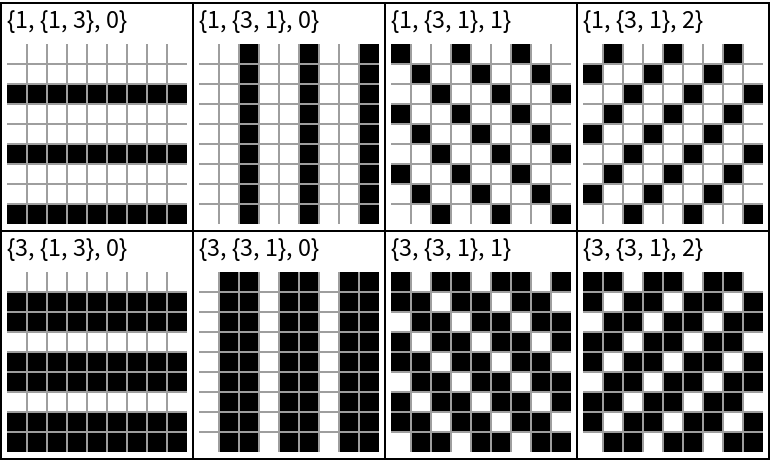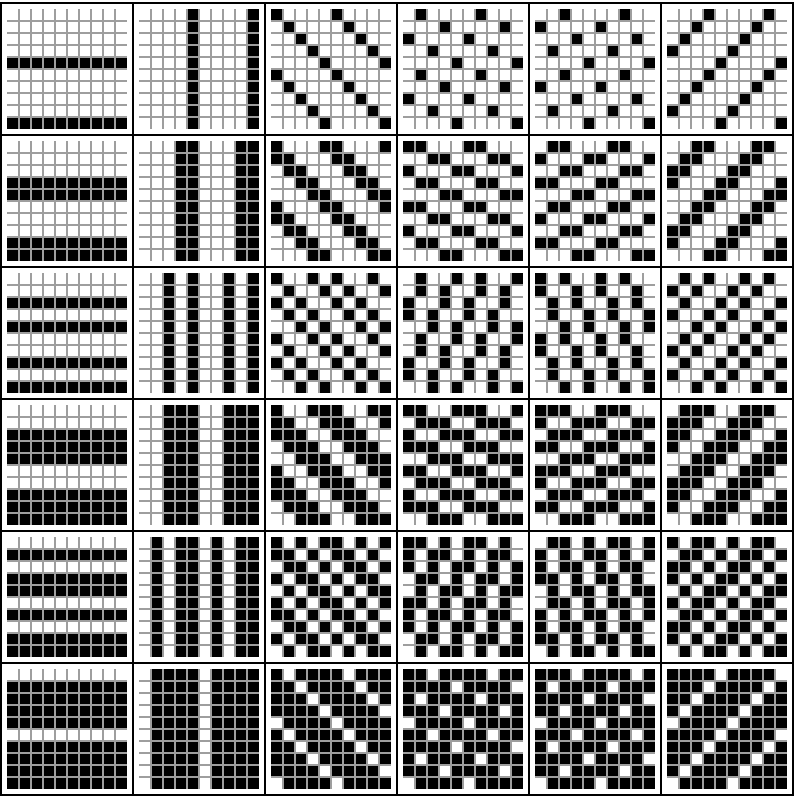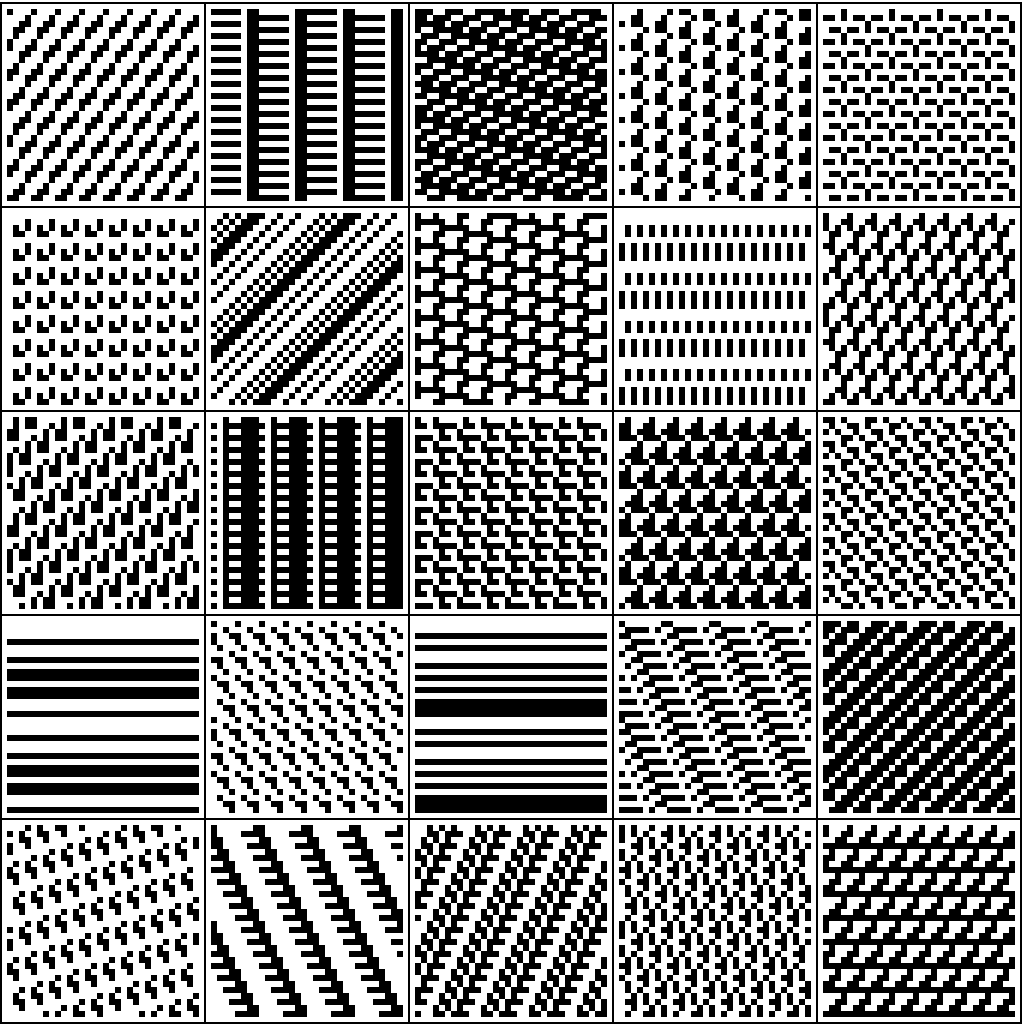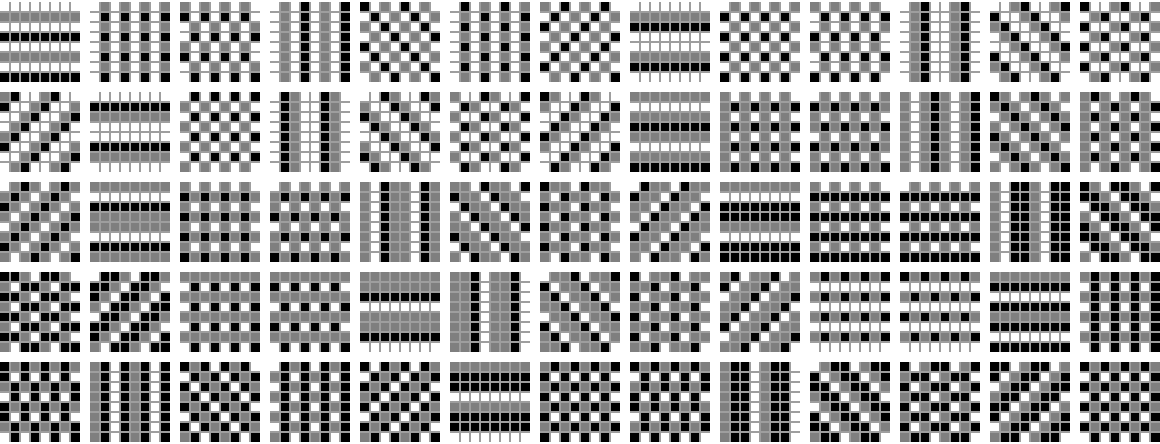Details
Patterns are given as generators for ResourceFunction["PeriodicPatternGenerator"][n,{x,y},disp:0,b:2]: Create a periodic square array with side length of x×y based on an x×y rectangle filled with the digits of integer n in base 2 (or b), where the rectangle is repeated on subsequent rows with displacement disp.
Periodic patterns can be equivalent by toroidal displacement. For example, an 8×8 checkerboard pattern with a black square in the lower right corner is equivalent to an 8×8 checkerboard pattern with a white square in the lower right corner after a toroidal displacement of {a,b} for any odd a+b.
Periodic patterns similar by rotations, reflections, color reversals and skew displacement are considered distinct in these datasets.
For the counts below, an n-ary pattern is assumed to have n colors. An exception is made for binary, where order 1 has both all 0 and all 1 tilings.
Up to order 16, there are 2, 3, 8, 20, 36, 112, 144, 452, 740, 1824, 2232, 9848, 8820, 28302, 54015, 129064 distinct binary patterns.
Up to order 10, there are 0, 0, 8, 65, 180, 1123, 2064, 11391, 27187, 104774 distinct ternary patterns.
![Grid[Partition[Column[{#, ArrayPlot[ArrayFlatten[Table[
ResourceFunction["PeriodicPatternGenerator"][#], {3}, {3}]], PixelConstrained -> 10, Mesh -> {8, 8}]}] & /@ order3, 4], Frame -> All]](https://www.wolframcloud.com/obj/resourcesystem/images/d7f/d7fd063a-0a96-4c8c-b78e-353ae3c5b4a1/3908e94f94904cbc.png)


![Grid[Partition[
Tooltip[ArrayPlot[
ArrayFlatten[
Table[ResourceFunction[
"PeriodicPatternGenerator"][#], {2}, {2}]], PixelConstrained -> 6, Mesh -> {9, 9}], #] & /@ order5, 6], Frame -> All]](https://www.wolframcloud.com/obj/resourcesystem/images/d7f/d7fd063a-0a96-4c8c-b78e-353ae3c5b4a1/0876e37e5d1bd631.png)

![Style[Grid[
Partition[
Column[{#, MatrixForm[
ResourceFunction["PeriodicPatternGenerator"][#], #]}] & /@ ResourceData[\!\(\*
TagBox["\"\<Periodic Patterns\>\"",
#& ,
BoxID -> "ResourceTag-Periodic Patterns-Input",
AutoDelete->True]\)][{5, 2}], 9], Frame -> All], 8]](https://www.wolframcloud.com/obj/resourcesystem/images/d7f/d7fd063a-0a96-4c8c-b78e-353ae3c5b4a1/33a8ba50fa7310ba.png)

![Grid[Partition[Tooltip[ArrayPlot[ArrayFlatten[Table[
ResourceFunction["PeriodicPatternGenerator"][#], {2}, {2}]], PixelConstrained -> 3, Frame -> False], #] & /@ RandomSample[ResourceData[\!\(\*
TagBox["\"\<Periodic Patterns\>\"",
#& ,
BoxID -> "ResourceTag-Periodic Patterns-Input",
AutoDelete->True]\)][{16, 2}], 25], 5], Frame -> All]](https://www.wolframcloud.com/obj/resourcesystem/images/d7f/d7fd063a-0a96-4c8c-b78e-353ae3c5b4a1/4fc092ce4a330e06.png)

![Grid[Partition[
Tooltip[ArrayPlot[
ArrayFlatten[
Table[ResourceFunction[
"PeriodicPatternGenerator"][#], {2}, {2}]], PixelConstrained -> 5, Mesh -> {7, 7}], #] & /@ ResourceData[\!\(\*
TagBox["\"\<Periodic Patterns\>\"",
#& ,
BoxID -> "ResourceTag-Periodic Patterns-Input",
AutoDelete->True]\)][{4, 3}], 13]]](https://www.wolframcloud.com/obj/resourcesystem/images/d7f/d7fd063a-0a96-4c8c-b78e-353ae3c5b4a1/4f90e57665932989.png)
